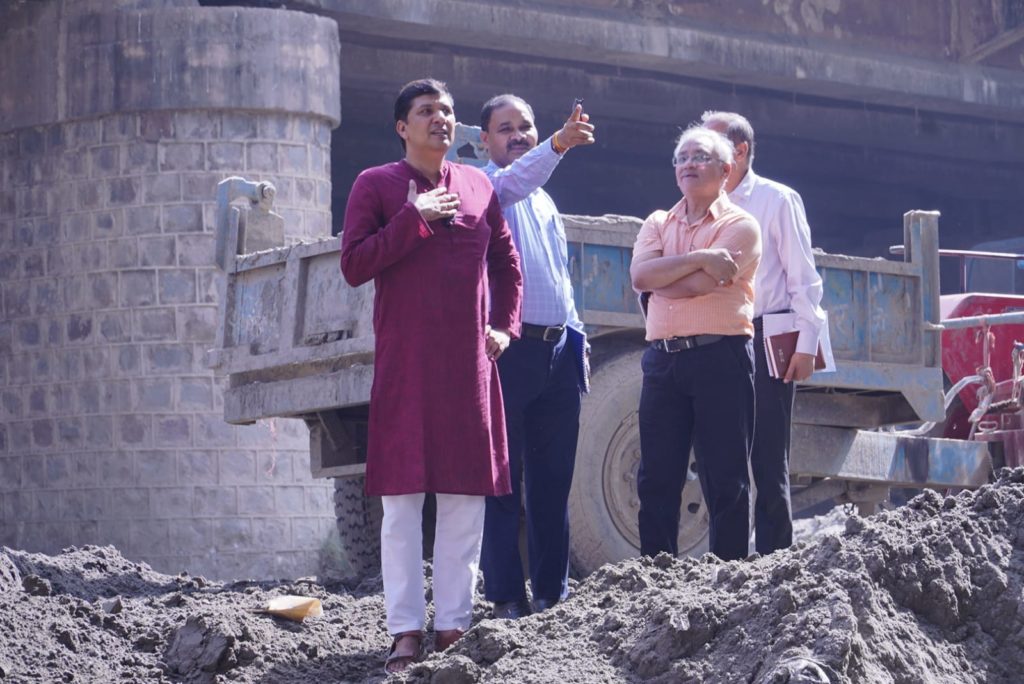Anticipating the imminent monsoon season, Delhi’s Irrigation and Flood Control Minister, Shri Saurabh Bharadwaj, visited the Yamuna Barrage at ITO on Tuesday to assess its current state. Accompanied by departmental officials, the Irrigation and Flood Control Minister inspected the barrage, receiving comprehensive updates on the measures being taken to manage potential flood scenarios. Last year, this very barrage caused significant flooding in the Yamuna, leading to waterlogging and severe inconvenience for nearby residents. Learning from past experiences, the government has proactively commenced preparations to prevent a repeat of last year’s challenges. Minister Shri Saurabh Bharadwaj’s visit highlights the administration’s commitment to safeguarding Delhi against monsoon-induced disruptions.
While touring the barrage, Delhi Irrigation and Flood Control Minister Shri Saurabh Bharadwaj explained that the amount of rainfall last year and the volume of water released into the Yamuna from Haryana were unprecedented in decades, which resulted in the flood situation in the Yamuna. Although this barrage falls under the jurisdiction of the Haryana government and its operation is their responsibility, this time, the Delhi Irrigation and Flood Control Department has coordinated with the Haryana government to prepare for the potential issues. The department has made such preparations that even if the same amount of water as last time flows into the Yamuna, there will be no flooding in Delhi, and the Yamuna’s water will not reach the roads.
Regarding the large machines present on site, which were being used to remove accumulated silt around the barrage, The Irrigation and Flood Control Minister stated that this work has been ongoing for the past three months, and a significant amount of silt around all the barrages has already been removed, and all the barrages have been opened. Some barrages, which could not be opened, have been cut and removed to ensure that there is no obstruction to the water flow.
While informing about a new technique to tackle the flood situation, Minister Shri Saurabh Bharadwaj stated that this time, to prevent water accumulation in the Yamuna and avoid a flood situation, a new experiment has been conducted by the Delhi Irrigation and Flood Control Department for the first time. This experiment is called the “Pilot Cut”, under this experiment, small channels are dug from the accumulated soil in front of the barrage extending far beyond. During this process, small islands of soil are formed between the artificial channels created in the Yamuna.
“When rainwater is released from Haryana, it will flow swiftly through these artificial channels, carrying with it the small soil islands, thereby eliminating any possibility of water stagnation and allowing the water to flow swiftly ahead. This procedure ensures that there will be no likelihood of water accumulating in the Yamuna, terminating all potential flood scenarios due to unhindered water flow,” he added.
The Irrigation and Flood Control Minister mentioned, “During the last flood in the Yamuna, there were incidents of regulators breaking in some places. This time, to prevent such situations, all regulators have been repaired thoroughly. The broken regulator has been replaced with a new one, and all other regulators have been adequately checked and serviced to prevent any issues or accidents in case of water inflow into the Yamuna. All the regulators have been tested once, and he is confident that there will be no repeat of last year’s incidents.”
“Water accumulation in urban areas has various causes, which fall under the responsibility of different departments such as the DDA, PWD, and MCD. As the Minister of the Irrigation and Flood Control Department responsible for handling flood situations in the Yamuna, they have prepared this year in such a way that they are hopeful there will be no flood situation in the Yamuna this year,” Shri Saurabh Bharadwaj concluded.


